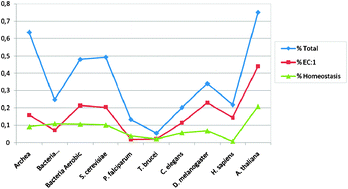This paper is a continuation of our study of the connection between the changing environment and the changing use of particular elements in organisms in the course of their combined evolution (Decaria, Bertini and Williams, Metallomics, 2010, 2, 706). Here we treat the changes in copper proteins in historically the same increasingly oxidising environmental conditions. The study is a bioinformatic analysis of the types and the numbers of copper domains of proteins from 435 DNA sequences of a wide range of organisms available in NCBI, using the method developed by Andreini, Bertini and Rosato in Accounts of Chemical Research 2009, 42, 1471. The copper domains of greatest interest are found predominantly in copper chaperones, homeostatic proteins and redox enzymes mainly used outside the cytoplasm which are in themselves somewhat diverse. The multiplicity of these proteins is strongly marked. The contrasting use of the iron and heme iron proteins in oxidations, mostly in the cytoplasm, is compared with them and with activity of zinc fingers during evolution. It is shown that evolution is a coordinated development of the chemistry of elements with use of novel and multiple copies of their proteins as their availability rises in the environment.

You have access to this article
 Please wait while we load your content...
Something went wrong. Try again?
Please wait while we load your content...
Something went wrong. Try again?


 Please wait while we load your content...
Please wait while we load your content...